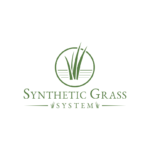Best Choice for Golf Courses?
There is no denying that many golf courses in the world use real grass. However, artificial turf may be a better choice for several reasons. Artificial turf can be an aesthetically pleasing and sustainable option for individuals who want to play or practice their golf game in regions where growing conditions do not suit natural grass.
Costs associated with maintaining real grass can be quite high. The costs associated with artificial turf are minimal because the turf is not vulnerable to weather conditions, bugs, and disease. Additionally, there are no post-construction costs required for maintaining an artificial surface as opposed to a natural one that must be fertilized, watered, mowed, and aerated. In fact, the reduced maintenance associated with artificial turf allows courses to save approximately 50-60% on their bills.
What Exactly is Synthetic Grass?
Synthetic grass is an artificial product that is made from a combination of polyethylene and polypropylene fibers. It is designed to resemble natural grass. In fact, some brands have been tested for durability against meteorological phenomena such as hail, sleet, snow, and rain. This type of surface can be used on golf courses, but it is also used for home lawns, sports fields, and playground kicking areas.
This type of material is excellent for golf courses because it is durable and requires little maintenance. Artificially grown grass also has drainage capabilities that allow the turf to recover from wet conditions, which many golf courses experience during their respective rainy seasons. Furthermore, artificial surfaces are cost-efficient and provide a well-manicured appearance all year long.
What are the Types of Artificial Turf?
There are different types of artificial turf that can be used on golf courses. FieldTurf is one of the most popular choices for golf courses because it uses a foam base underneath its infill, which provides greater shock absorbency and reduces the risk of injury.
Another popular type of artificial turf is the third generation product. This turf has a sand and rubber infill, which allows for easy drainage of water. The sand also adds to the stability of the surface, giving it additional load-bearing capabilities. This type of surface is very beneficial because it can provide excellent results on slopes within the golf course where traditional grass could not grow.
What are the Advantages of Using Artificial Turf on Golf Courses?
One advantage of using artificial turf is that it can be installed in areas hard-hit by natural disasters such as hurricanes and floods. This surface also allows golf courses to play their sports during bad weather conditions when natural grass cannot survive. The lack of maintenance associated with artificial turf can also have positive effects because it allows golf courses to focus more of their money on other aspects of the course.
What are the Disadvantages?
One major disadvantage is that some brands may not be set deep enough into the ground, which will cause them to shift and slide over time. They may also have seams that can be hazardous to golfers. Some people also argue that natural grass creates a more rewarding and aesthetically pleasing experience for golfers. Still, many modern courses have incorporated aspects of artificial turf into their layouts in order to provide increased durability and sustainability.
Why do Golfers Prefer Artificial Grass?
Many golfers prefer an artificial surface for a variety of reasons. For example, it is easier to play on a consistent surface that does not have to be watered or fertilized. Also, the need for aeration and overseeding is eliminated because the grass blades do not grow into cushiony tufts that can interfere with a striking shot. Furthermore, many golfers feel that they can generate more club speed on artificial grass than on natural turf because the ball tends to roll further and truer.
For these reasons and more, artificial turf is rapidly gaining popularity around the world as a top choice for courses. It allows courses to focus more of their attention and money towards hiring quality staff and providing quality services to golfers.
Considering the costs associated with taking care of the natural grass at golf courses, it is no surprise that more and more are turning towards artificial surfaces for their excellent durability, reduced management time, and consistent looks.
Closing Thoughts
Artificial turf is a top choice for golf courses because it provides a surface that can be used all year round and requires little maintenance. In addition, it allows money that would normally be spent on natural grass to be allocated to other aspects of the course. This type of turf generates increased interest among golfers who prefer consistency and predictability from their playing surfaces.
As the increase of golf course closures reaches an all-time high, it is important for courses to begin considering their options to stay competitive. The use of artificial turf can be beneficial because many consider it superior to natural grass in terms of performance and appearance. By choosing this innovative option over traditional lawns, more courses will be able to play year-round and focus on creating a better experience for all of their players.



